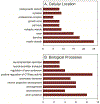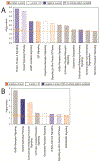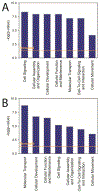Proteomic and transcriptional profiling of rat amygdala following social play
- PMID: 31493430
- PMCID: PMC6783381
- DOI: 10.1016/j.bbr.2019.112210
Proteomic and transcriptional profiling of rat amygdala following social play
Abstract
Social play is the most characteristic form of social interaction which is necessary for adolescents to develop proper cognitive, emotional, and social competency. The information available on neural substrates and the mechanism involved in social play is limited. This study characterized social play by proteomic and transcriptional profiling studies. Social play was performed on male Sprague Dawley rats on postnatal day 38 and protein and gene expression in the amygdala was determined following behavioral testing. The proteomic analysis led to the identification of 170 differentially expressed proteins (p ≤ 0.05) with 67 upregulated and 103 downregulated proteins. The transcriptomic analysis led to the identification of 188 genes (FDR ≤ 0.05) with 55 upregulated and 133 downregulated genes. DAVID analysis of gene/protein expression data revealed that social play altered GABAergic signaling, glutamatergic signaling, and G-protein coupled receptor (GPCR) signaling. These data suggest that the synaptic levels of GABA and glutamate increased during play. Ingenuity Pathway Analysis (IPA) confirmed these alterations. IPA also revealed that differentially expressed genes/proteins in our data had significant over representation of neurotransmitter signaling systems, including the opioid, serotonin, and dopamine systems, suggesting that play alters the systems involved in the regulation of reward. In addition, corticotropin-releasing hormone signaling was altered indicating that an increased level of stress occurs during play. Overall, our data suggest that increased inhibitory GPCR signaling in these neurotransmitter pathways occurs following social play as a physiological response to regulate the induced level of reward and stress and to maintain the excitatory-inhibitory balance in the neurotransmitter systems.
Keywords: Amygdala; Behavior; Gene expression; Protein expression; Reward; Social play.
Copyright © 2019 Elsevier B.V. All rights reserved.
Figures







Similar articles
-
Anhedonia Following Early-Life Adversity Involves Aberrant Interaction of Reward and Anxiety Circuits and Is Reversed by Partial Silencing of Amygdala Corticotropin-Releasing Hormone Gene.Biol Psychiatry. 2018 Jan 15;83(2):137-147. doi: 10.1016/j.biopsych.2017.08.023. Epub 2017 Sep 7. Biol Psychiatry. 2018. PMID: 29033027 Free PMC article.
-
Proteomic and metabolomic characterization of amygdala in chronic social defeat stress rats.Behav Brain Res. 2021 Aug 27;412:113407. doi: 10.1016/j.bbr.2021.113407. Epub 2021 Jun 8. Behav Brain Res. 2021. PMID: 34111472
-
[Altered Expression of Neurotransmitters Systems' Genes in the Ventral Tegmental Area of Depressive Male Mice: Data of RNA-Seq].Zh Vyssh Nerv Deiat Im I P Pavlova. 2017 Jan;67(1):113-128. Zh Vyssh Nerv Deiat Im I P Pavlova. 2017. PMID: 30695556 Russian.
-
The pleasures of play: pharmacological insights into social reward mechanisms.Trends Pharmacol Sci. 2010 Oct;31(10):463-9. doi: 10.1016/j.tips.2010.06.008. Epub 2010 Aug 3. Trends Pharmacol Sci. 2010. PMID: 20684996 Free PMC article. Review.
-
In search of the neurobiological substrates for social playfulness in mammalian brains.Neurosci Biobehav Rev. 2011 Oct;35(9):1821-30. doi: 10.1016/j.neubiorev.2011.03.006. Epub 2011 Mar 22. Neurosci Biobehav Rev. 2011. PMID: 21414353 Review.
Cited by
-
Motor Stereotypic Behavior Was Associated With Immune Response in Macaques: Insight From Transcriptome and Gut Microbiota Analysis.Front Microbiol. 2021 Jul 29;12:644540. doi: 10.3389/fmicb.2021.644540. eCollection 2021. Front Microbiol. 2021. PMID: 34394017 Free PMC article.
-
Persistent proteomic changes in glutamatergic and GABAergic signaling in the amygdala of adolescent rats exposed to chlorpyrifos as juveniles.Neurotoxicology. 2021 Jul;85:234-244. doi: 10.1016/j.neuro.2021.05.012. Epub 2021 May 28. Neurotoxicology. 2021. PMID: 34058248 Free PMC article.
-
Amygdala circuit transitions supporting developmentally-appropriate social behavior.Neurobiol Learn Mem. 2023 May;201:107762. doi: 10.1016/j.nlm.2023.107762. Epub 2023 Apr 26. Neurobiol Learn Mem. 2023. PMID: 37116857 Free PMC article. Review.
-
Transcriptomic analysis of rat prefrontal cortex following chronic stress induced by social isolation - Relevance to psychiatric and neurodevelopmental illness, and implications for treatment.Neurobiol Stress. 2024 Oct 17;33:100679. doi: 10.1016/j.ynstr.2024.100679. eCollection 2024 Nov. Neurobiol Stress. 2024. PMID: 39502833 Free PMC article.
-
Paternal morphine exposure in rats reduces social play in adolescent male progeny without affecting drug-taking behavior in juvenile males or female offspring.Mol Cell Neurosci. 2023 Sep;126:103877. doi: 10.1016/j.mcn.2023.103877. Epub 2023 Jun 27. Mol Cell Neurosci. 2023. PMID: 37385516 Free PMC article.
References
-
- Pellis SM, Pellis VC, Attack and defense during play fighting appear to be motivationally independant behaviors in muroid rodents, Psychol. Rec 41 (1991) 175–184.
-
- Vanderschuren LJMJ, Trezza V, What the Laboratory Rat has Taught us About Social Play Behaviour: Role in Behavioral Development and Neural Mechanisms, The Neurobiology of Childhood 16 (2014) 189–212. - PubMed
-
- Meaney MJ, Stewart J, A descriptive study of social development in rat (Rattus Norvegicus), Anim. Behav 29 (1981) 34–45.
-
- Panksepp J, Beatty WW, Social deprivation and play in rats, Behavioral and neural biology 30(2) (1980) 197–206. - PubMed
-
- Plonsky M, Freeman PR, The effects of methadone on the social behavior and activity of the rat, Pharmacology, biochemistry, and behavior 16(4) (1982) 569–71. - PubMed
Publication types
MeSH terms
Substances
Grants and funding
LinkOut - more resources
Full Text Sources
Molecular Biology Databases

